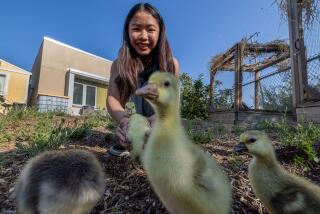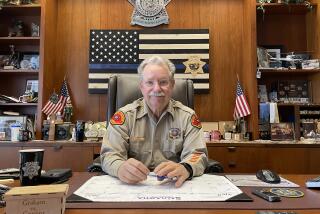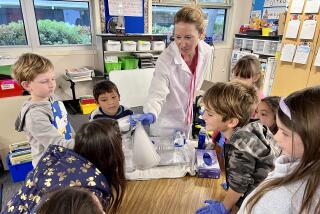Students eager to spend Saturdays in this classroom
The teacher ripped open the plastic bag and shook loose a skinned cat.
Splayed on its back, the ghastly feline still had tufts of sodden black-and-white fur clinging to its outstretched paws and head.
Its tongue lolled from its mouth, and the tiny hairs — papillae — that coated it stood on end. The sickly sweet smell of preservative wafted around the room.
“It got run over by a truck,” speculated one of the 11-year-old junior scientists, clad in a white lab coat and paper face mask. “No, I think they stabbed it,” another countered. “Rest in peace,” several students repeated after one another.
But when Andre Smalley, 11, of Culver City picked up the scalpel and began to split the cat down its thorax, the students were all business. Hands shot up when instructor Ariel Moradzadeh asked who wanted to make the next cut.
“Pectoral muscle! Sacrum!” they recited when Moradzadeh asked them to identify body parts.
The feline necropsy was part of a mass dissection that capped the fall human life session at a children’s science academy sponsored by Charles Drew University of Medicine and Science in Willowbrook. Students from fourth to 12th grade practiced slicing up and identifying pig parts, cow hearts and other embalmed specimens.
The Saturday Science Academy II, held on the Drew campus, enrolled 200 children this year in specialized courses, including anatomy, marine biology and natural sciences, that they generally won’t find at their regular schools, program director Lorraine Grey said. The program aims to give the pupils a head start on the skills they would need to become doctors, dentists and other medical professionals.
Many of the children come from South Los Angeles neighborhoods where rigorous science and math instruction is at a premium. Parents pay $50 a session; there are three yearly. The rest of the funding comes from the California Wellness Foundation and other grant-givers, Grey said.
Students from Drew , UCLA, USC, Cal State Dominguez Hills and other colleges provide the instruction. Moradzadeh, 22, a recent UCLA graduate who plans to start medical school next year, said he believes early exposure to hands-on science will help disadvantaged children gravitate toward medical careers.
“If my parents didn’t start me early on math games and problems, I never would have gotten where I did,” Moradzadeh said.
Several parents said their children had staged remarkable academic turnarounds after attending the classes. “When he got in the program, we brought his Fs up to Bs in less than four months,” Opal Holliday of Long Beach said of her 12-year-old son, Jonathan.
And they don’t have to drag their kids away from the video game console for the Saturday morning classes.
Indeed, the participants watched the dissection with rapt expressions. One lurched from the table when the odor grew strong; another hung back, saying, “I am not in the mood to throw up now.”
But others fought for a chance to put blade to cat. Elijah Wade, 12, a student at Woodcrest Nazarene Christian School in the Westmont neighborhood of South L.A., captured the whole process on his cellphone video camera, deftly transferring the phone to his other hand when it was his turn to slice.
“I want to be an FBI investigator and look inside people … and see what happened to them,” Elijah explained.
By the end of the session, one child was waving a blood vessel in the air, and the cat’s liver was lying in pieces on the table.
“It was kind of fun, but it’s kind of nasty at the same time,” said Darius Roddy-Moore, 11, who attends John Burroughs Middle School in Hancock Park.
More to Read
Sign up for Essential California
The most important California stories and recommendations in your inbox every morning.
You may occasionally receive promotional content from the Los Angeles Times.










